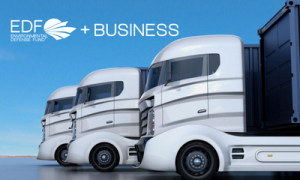Driving To Net-Zero: 5 Steps to Tackling Scope 3 Emissions for Shippers
In light of the Intergovernmental Panel on Climate Change’s latest report, and with the rapidly escalating effects of climate change, addressing Scope 3 emissions is a business imperative. Measuring, reporting, and including Scope 3 emissions in sustainability targets can be a challenge, especially for companies that outsource the transportation of goods via medium- and heavy-duty (MHD) trucks. But the short- and long-term benefits to business are clear and carry high potential to shield companies and the surrounding communities from the worst impacts of the climate crisis. For most companies, over 70% of total emissions come from their supply chains. Understanding Scope 3 emissions inventories can enable sustainability and procurement leads within large companies to better understand their value chains in terms of carbon intensity, remove inefficiencies, and create a range of business benefits including unearthing new trends and innovations.
The urgency to cut shippers’ Scope 3 emissions from the transportation value chain
Transportation accounts for more than a quarter of US greenhouse gas emissions and 26% of that is attributed to MHD trucks. Emissions from trucks moving freight account for nearly 60% of the industry’s climate footprint. Beyond environmental impacts, the movement of goods has real dangers for people and communities, as historically overburdened communities – located near warehouses and depots – disproportionately bear the brunt of that pollution.
For fleets – companies that own and operate vehicles like U.S. Foods. Pepsi Co. & Amazon – transportation emissions are under Scope 1.
For shippers – companies that do not own their own trucks, but contract transportation suppliers for moving their goods like Nike, Under Armour, Dollar Tree – those emissions are Scope 3.
Proactively engaging their transportation suppliers is paramount to reducing shippers’ Scope 3 emissions. Beyond ensuring their supply chain is on track to being carbon-free, shippers can reduce their Scope 3 emissions by leveraging their purchasing power and driving the accelerated deployment of MHD electric vehicles among trucking service providers. This clear market signal by shippers will incentivize fleets to deploy more zero-emission solutions, backed by the confidence of their customers’ support, thus future-proofing their business.
The steps below offer a clear path for companies to reduce their carbon footprint quickly, prioritize the health of historically overburdened communities, and lead the transportation industry’s shift to MHD electric vehicles.
5 steps shippers can take now to accelerate the transition to zero-emission fleets
1. COMMIT: Establish net-zero climate goals and greenhouse gas (GHG) reduction targets specifically for transportation-related emissions. This can help build credibility and enable companies to seek out zero-emission trucking solutions within their value chain operations. Industry leaders in the Consumer-Packaged Goods (CPG) segments like Unilever and Proctor & Gamble (P&G) have set ambitious targets to deliver net-zero supply chains by 2039 and 2040, respectively.
2. DISCLOSE: A business can’t manage what it can’t measure. Work with your supply chain partners to report progress on yearly emissions from trucking vendors. These should be part of a broader disclosure of transportation emissions broken down by freight modes as applicable to the company and its operations.
3. PLAN: Identify near and longer-term options to optimize your logistics operations and work with transportation suppliers to develop a plan to reduce emissions. Your plan of action, as outlined in EDF’s Green Freight Handbook, should include three core planks:
- Get the most of our every move by focusing on increase the capacity utilization of existing freight moves;
- Choose the most carbon-efficient mode of transportation, such as looking for opportunities to move goods from truck to rail;
- Demand cleaner equipment, such as the use of electric trucks, from your carriers.
Shippers need to make clear their long-term commitment to working with zero-emission solution providers to instill confidence in carriers to scale their procurement of electric trucks.
4. DEPLOY: Shippers have a critical role to play in the transition to zero-emission freight movement. Near-term leadership is needed to develop the processes and solutions for making a transition to zero-emission trucks work. For example, shippers need to work with their carriers to establish charging infrastructure solutions, especially for dedicated service providers. A strategic collaboration kicked off between Uber Freight, CHEP and, WattEV to deploy electric trucks in Southern California – a promising example of transportation suppliers like WattEV committing to provide electric trucking capacity to Uber Freight shippers, starting with CHEP. Other examples include PepsiCo and Schneider National, who recently collaborated to provide zero-emission trucking services.
5. ADVOCATE: Scaling zero-emission freight solutions will require that we establish the conditions in which these solutions can thrive. Public policy has a critical role to play in creating these conditions. Protective emission standards and market targets, such as the Advanced Clean Truck Program and the EPA Phase 3 GHG standards, ensure that fleets and shippers have access to zero-emission options. Purchase incentives and tax credits, such as those contained in the Inflation Reduction Act reduce the upfront investments companies must make and help scale these solutions. Utility programs, such as those currently under consideration in New York, are essential to enabling the build out of the charging infrastructure necessary to power our zero-emission future.
Driving innovation through sustainable operations goes a long way in reducing Scope 3 emissions. Though deploying electric trucks involves a significant capital outlay, it’s a worthwhile venture thanks to tax incentives available today, declining costs of acquisition, and more benefits attributable to zero-emission trucks, such as reputational benefits and first-mover advantages. If done right, electrification can ensure the long-term viability of the company in a changing world.
The private sector must capitalize on available opportunities to accelerate the trucking industry towards the energy transition and deliver benefits for human health, our environment, and the economy.
